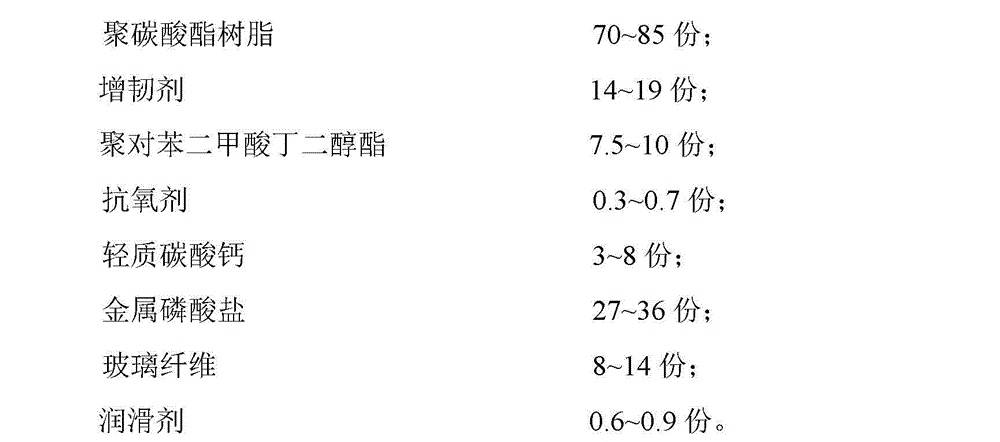Halogen-free flame-retardant glass fiber-reinforced polycarbonate alloy material
A technology of glass fiber and polycarbonate, which is applied in the field of polycarbonate alloy materials, can solve the problems that the flame retardancy is not enough, restricts, and affects people's life and property safety, and achieves the effect of high modulus and high rigidity
- Summary
- Abstract
- Description
- Claims
- Application Information
AI Technical Summary
Problems solved by technology
Method used
Image
Examples
Embodiment 1
[0017] 70 parts of bisphenol A type polycarbonate resin;
[0018] 19 parts of acrylonitrile-butadiene-styrene copolymer;
[0019] 10 parts of general-purpose polybutylene terephthalate;
[0020] 0.7 parts of 2,5 di-tert-butylhydroquinone;
[0021] 3 parts of surface-treated active calcium carbonate;
[0022] The mass percentage is 27 parts of the mixture of 50% ammonium polyphosphate and 50% melamine urate;
[0023] 10 parts of alkali-free glass fiber with a length of 3 mm;
Embodiment 2
[0026] 85 parts of bisphenol A type polycarbonate resin;
[0027] 16 parts of acrylonitrile-butadiene-styrene copolymer;
[0028] 7.5 parts of general-purpose polybutylene terephthalate;
[0029] 0.5 parts of 2,5 di-tert-butyl hydroquinone;
[0030] 8 parts of surface-treated active calcium carbonate;
[0031] 36 parts of mixtures of 50% ammonium polyphosphate and 50% melamine urate by mass percentage;
[0032] 8 parts of alkali-free glass fiber with a length of 3 mm;
Embodiment 3
[0035] 75 parts of bisphenol A type polycarbonate resin;
[0036] Acrylonitrile-butadiene-styrene copolymer 14 parts;
[0037] 8.5 parts of general-purpose polybutylene terephthalate;
[0038] 0.3 parts of 2,5 di-tert-butylhydroquinone;
[0039] 4 parts of surface-treated active calcium carbonate;
[0040] 33 parts of mixtures of 50% ammonium polyphosphate and 50% melamine urate by mass percentage;
[0041] 14 parts of alkali-free glass fiber with a length of 3mm;
PUM
| Property | Measurement | Unit |
|---|---|---|
| length | aaaaa | aaaaa |
| bending strength | aaaaa | aaaaa |
| flexural modulus | aaaaa | aaaaa |
Abstract
Description
Claims
Application Information
 Login to View More
Login to View More - R&D
- Intellectual Property
- Life Sciences
- Materials
- Tech Scout
- Unparalleled Data Quality
- Higher Quality Content
- 60% Fewer Hallucinations
Browse by: Latest US Patents, China's latest patents, Technical Efficacy Thesaurus, Application Domain, Technology Topic, Popular Technical Reports.
© 2025 PatSnap. All rights reserved.Legal|Privacy policy|Modern Slavery Act Transparency Statement|Sitemap|About US| Contact US: help@patsnap.com

